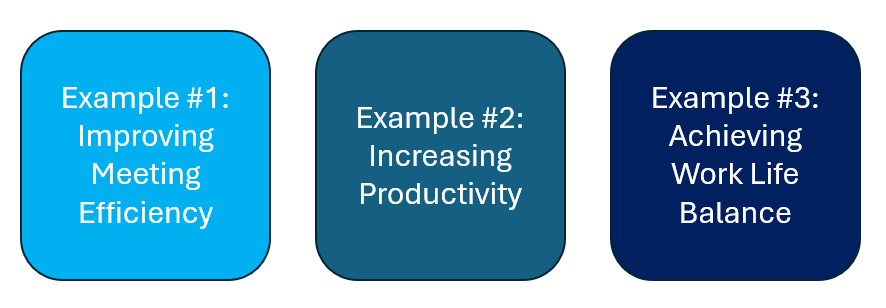- Home
- 7 Steps of Goal Setting
- Setting a SMART Goal for Time Management
Boost Productivity: A SMART Goal for Time Management (with examples)
Welcome to the world of time management, where SMART goals aren’t just a buzzword but a lifeline for busy professionals like us. If you're finding yourself buried under emails on a Monday morning and your to-do list feels never-ending, you’re not alone. Luckily, setting SMART goals can be your ticket to increased productivity and better work-life balance. This article will guide you through the process of setting a SMART goal for time management, providing practical examples, so that your path to success is well-lit and your productivity is at an all-time high.
What are SMART Goals?
Imagine trying to assemble a piece of Ikea furniture without instructions. Setting goals without a SMART structure can feel much the same—frustrating and inefficient. The acronym SMART stands for:

|
S |
Specific |
Clearly define what you want to accomplish. The challenge for many is to resist vague goals like "be better at managing time." Instead, zoom in on what "better" means. Perhaps it’s allocating thirty minutes every morning to plan your day or dedicating specific hours for emails. |
|
M |
Measurable |
Establish criteria for measuring progress and success. With time management SMART goal examples, think about how much time you are actively saving or how often you're completing tasks ahead of schedule. |
|
A |
Achievable |
Set realistic goals that are attainable given your resources and constraints. The gentle reminder here is to be realistic. As much as we might want to overhaul our scheduling system overnight, it's more achievable to tackle one aspect of time management for a week, such as scheduling breaks.
|
|
R |
Relevant |
Check that your goals align with your broader objectives and values, ensuring it isn’t a detour. For instance, a goal should enhance your work life, not overwhelm it.
|
|
T |
Time-bound |
Set a deadline to create a sense of urgency and keep you focused. It might be as simple as aiming to integrate a new time management tool into your routine by month's end.
|
In short, SMART goals are a framework designed to provide clarity, focus, and motivation by ensuring your goals are well-defined and trackable. It's a structured approach that keeps you grounded, making it easy to learn and easy to use.
Examples of Setting a SMART Goal for Time Management
I have dedicated the past 20 years to the corporate sector, specializing in helping individuals refine their work habits to boost productivity. Here are some examples of SMART goals for time management that I have used. When setting those goals these people have used a template for smart goal setting.

1. SMART Goal for Time Management Example #1: Improving Meeting
Efficiency
Here is a common SMART goal for time management:
SMART Goal: Reduce the duration of weekly team meetings from 1 hour to 30 minutes within the next month by implementing a strict agenda and time limits for each topic.
When you look closely at this goal you can see that it conforms to the SMART Criteria. The goal is:
- Specific: The goal is to cut down the time spent in weekly team meetings.
- Measurable: The success of this goal can be measured by comparing the current meeting duration (1 hour) to the target duration (30 minutes).
- Achievable: This goal is realistic if you implement a strict agenda and enforce time limits for each discussion point. For example, allocate 5 minutes for updates, 10 minutes for discussing new projects, and 15 minutes for Q&A.
- Relevant: Reducing meeting time is relevant because it allows team members to spend more time on their core tasks, thereby increasing overall productivity.
- Time-bound: Setting a deadline of one month creates a sense of urgency and helps keep the team focused on achieving this goal.
Action steps to take today:
- Start by analyzing your current meeting structure. Identify areas where time is often wasted, such as off-topic discussions or lengthy updates.
- Create a detailed agenda before each meeting and share it with your team in advance.
- During the meeting, stick to the agenda and gently remind participants of the time limits.
- After a few weeks, review the effectiveness of these changes and make adjustments as needed.

Three common questions I face with this SMART Goal for Time Management
These FAQs address some of the common challenges I have faced with clients and provide practical solutions to help you achieve your SMART goals effectively.
Q1: How can I ensure that meetings stay on track and within the time limits? Response: Create a detailed agenda and share it with participants before the meeting. Assign a timekeeper to monitor the time and gently remind everyone of the time limits for each topic.
Q2: What if important discussions need more time than allocated? Response: f a topic requires more time, consider scheduling a follow-up meeting or continuing the discussion via email or a collaborative platform. This ensures that the main meeting stays on track.
Q3: How can I handle participants who tend to dominate the conversation? Response: Set ground rules at the beginning of the meeting, such as allowing everyone to speak and limiting individual speaking time. Encourage quieter participants to share their thoughts.
2. Time Management SMART Goal Example #2: : Enhancing Daily
Productivity
Here is another common SMART goal for time management:
SMART Goal: Spend 3 hours each day on high-priority tasks without interruptions starting next Monday and review progress weekly by using time-blocking techniques and minimizing distractions.
This conforms to the SMART Criteria because the goal is:
- Specific: The goal is to increase the amount of uninterrupted time spent on high-priority tasks.
- Measurable: Measure success by tracking the number of hours spent on focused work each day.
- Achievable: This goal is attainable by using time-blocking techniques, such as scheduling specific blocks of time for focused work and minimizing distractions (e.g., turning off notifications, setting boundaries with colleagues).
- Relevant: Enhancing daily productivity is relevant because it directly impacts your ability to complete important tasks efficiently and effectively.
- Time-bound: Starting next Monday and reviewing progress weekly provides a clear timeline for implementing and assessing this goal.
Action steps you can take today:
- Begin by identifying your high-priority tasks for the week.
- Use a calendar or planner to block out 3-hour periods each day dedicated to these tasks.
- During these blocks, eliminate potential distractions by turning off email notifications, setting your phone to Do Not Disturb, and informing colleagues of your focused work time.
- At the end of each week, review your progress and adjust your time blocks as necessary to ensure you are consistently meeting your productivity goals.

Three common questions I face with this SMART Goal for Time Management
These FAQs address some of the common challenges I have faced with clients and provide practical solutions to help you achieve your SMART goals effectively.
Q1: How do I minimize distractions during my focused work time? Response: Turn off notifications on your devices, set your phone to Do Not Disturb, and inform colleagues of your focused work periods. Use noise-canceling headphones or find a quiet workspace if possible.
Q2: What if urgent tasks come up during my blocked time? Response: While it’s important to stay flexible, try to handle urgent tasks quickly and return to your focused work. If interruptions are frequent, reassess your time blocks and adjust as needed.
Q3: How can I stay motivated to stick to my time blocks? Response: Break your work into smaller, manageable tasks and reward yourself after completing each block. Regularly review your progress and celebrate small wins to stay motivated.
3. SMART Goal Time Management Example #3: Achieving
Work-Life Balance
Here is another very common SMART goal for time management:
SMART Goal: Limit work to 45 hours per week over the next two months by delegating tasks and improving time management during office hours to improve personal well-being and family relationships.
This conforms to the SMART Criteria because the goal is:
- Specific: The goal is to reduce the number of hours worked each week to 45.
- Measurable: Track the number of hours worked each week to ensure it does not exceed 45.
- Achievable: This goal is achievable by delegating tasks to team members and improving time management during office hours. For example, prioritize tasks, set clear deadlines, and avoid unnecessary meetings.
- Relevant: Achieving work-life balance is relevant because it enhances personal well-being and strengthens family relationships.
- Time-bound: Implementing this change over the next two months provides a clear timeframe for achieving and maintaining this goal.
Action steps to take today:
- Start by analyzing your current workload and identifying tasks that can be delegated to others.
- Communicate with your team to ensure they understand their responsibilities and deadlines.
- Use time management techniques, such as prioritizing tasks based on urgency and importance (e.g. the Eisenhower Matrix), to make the most of your office hours.
- Set boundaries for after-hours work, such as not checking emails after a certain time.
- Over the next two months, monitor your work hours and make adjustments as needed to maintain a healthy work-life balance.

Three common questions I face with this SMART Goal for Time Management
These FAQs address some of the common challenges I have faced with clients and provide practical solutions to help you achieve your SMART goals effectively.
Q1: How can I delegate tasks effectively without overburdening my team? Response: Clearly communicate the tasks and expectations to your team members. Provide necessary resources and support, and encourage open communication to address any concerns or challenges. Also consider whether you are delegating your strengths or your weaknesses - the approach is different!
Q2: What if I struggle to disconnect from work after hours? Response: Establish a routine to transition from work to personal time, such as a short walk or a hobby. Set boundaries, like not checking emails after a certain time, and communicate these boundaries to your colleagues.
Q3: How can I ensure that my work hours don’t exceed the set limit? Response: Track your work hours using a time management app or a simple log. Regularly review your workload and prioritize tasks to ensure you stay within the 45-hour limit. If necessary, discuss workload adjustments with your supervisor.
Conclusion
Setting SMART goals is one side of the coin. The other side is tackling the hurdles. It's easy to feel the pressure that comes with new strategies. But remember, the essence of time management SMART goal examples is to simplify your process, not complicate it further. One trick is to maintain flexibility within your SMART goals, giving space for unexpected challenges. Remember, you're not just setting goals—you’re crafting a roadmap to a more balanced and controlled work life. Let the time management SMART goal examples serve as a beacon to unlock a smoother, more fulfilling professional journey.
New! Comments
Have your say about what you just read! Leave me a comment in the box below.